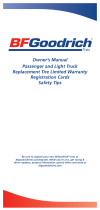Page is loading ...

page: 1
Your Information Pack
Dear user,
You will find below the content of your information pack, it gathers all information
you will need to buy the right tire for your vehicle.
Here is the information from michelinman.com on your tire search for :
Your selected tire
MICHELIN
®
Defender
®
LTX
®
M/S
Light Truck, SUV/Crossover
Our Best Just Got Better. The MICHELIN® Defender® LTX® M/S combines the proven tread design of the LTX® M/S2
with Evertread™ compound to provide durable tread life, no matter the season.
Ultimate Treadlife All-Season Safety Eco-friendly All-season
70
Key benefits
Michelin always aims to bring together multiple performances.
At MICHELIN, we continuously push safety, durability and fuel efficiency, and even more performances, all
at the same time and with no trade-offs. That’s what we mean by MICHELIN® Total Performance™, which
has and will always be our difference on every tire.
Improved Tread Life in
Severe Conditions
Evertread™ compound helps the MICHELIN®
Defender® LTX® M/S last 10% longer in severe
conditions than the MICHELIN® LTX® M/S2.
1
Excellent Wet and Snow
Traction
The MICHELIN® Defender® LTX® M/S tire offers
shorter wet stopping distances and better snow
traction than leading competitive long-warranty
tires.
2
Eco-Friendly
MaxTouch Construction™ helps the MICHELIN®
Defender® LTX® M/S save you up to 65 gallons
of fuel over the life of the tire, compared to a
leading competitive tire.
3

page: 2
Keep in mind
• If the tire you’ve selected is not immediately available at your dealer, you can always ask them to order it. It may be available
in just 1 – 2 days.
• Remember that a good price is not always a good value : a tire that lasts longer, helps you save on fuel, and keeps you safe in
every condition is a better value in the long run.

page: 3
Manufacturer's Suggested Retail Price (MSRP) is for a tire only (i.e., excluding services such as mounting, balancing and tire
disposal) and is applicable for the contiguous United States. Actual pricing may vary based on retailer, region, tire size and
other factors. Retailers are free to set individual prices. Please check with your local Michelin tire dealer for pricing near you.
1. Based on third-party treadwear tests using the MICHELIN® Defender® LTX® M/S tire versus the MICHELIN® LTX® M/S2
tire using size LT265/70R17 121/118R tires. Actual on-road results may vary.
2. Based on internal wet braking tests from 50 MPH using a 2011 Ford F-150, and on third-party snow traction tests using
ASTM Test Method F1805-12, versus the following competitors. Actual on-road results may vary. Average wet stopping
distance: MICHELIN® Defender® LTX® M/S : 265/70R17 115T : 136.5 ft, Bridgestone® Dueler™ H/L Alenza Plus :
P265/70R17 113T : 163.0 ft, Firestone® Destination™ LE2 : P265/70R17 113T : 144.5 ft, Goodyear® Wrangler SR-
A® : P265/70R17 113R : 170.7 ft Average snow traction: MICHELIN® Defender® LTX® M/S : 265/70R17 115T : 100%,
Bridgestone® Dueler™ H/L Alenza Plus : P265/70R17 113T : 49%, Firestone® Destination™ LE2 : P265/70R17 113T : 72%,
Goodyear® Wrangler SR-A® : P265/70R17 113R : 79%
3. Based on internal rolling resistance tests versus Goodyear® Wrangler SR-A®; using the MICHELIN® Defender® LTX® M/
S tire; in size LT265/70R17 121/118R. Actual on-road results may vary.
Government UTQG Ratings do not apply to light truck sized tires.
XL = Extra Load
>> The sizes shown are average design values for tires measured on specified measuring rim widths. Some tires may vary
from this value by +/-3% of the section height (affecting overall diameter), and +/-4% of the section width.
>> Section width varies approximately 0.2" (5mm) for every 0.5" change in rim width.
>> Tread patterns are often tuned to accomodate different tire widths. Tires for a particular dimension of a given tireline may
vary in appearance from the tire shown in the photograph.
WARNING: Serious or fatal injury may result from tire failure due to underinflation or overloading. To ensure correct air
pressure and vehicle load, refer to vehicle owner's manual or tire information placard on the vehicle. Serious injury or death
may result from explosion of tire/rim assembly due to improper mounting. Only tire professionals should mount tires and they
should never inflate beyond 40 psi to seat the beads. Before mixing types of tires in any configuration on any vehicle, be sure
to check the vehicle owner's manual for its recommendations.
DANGER: Never mount a 15" diameter tire on a 15.5" rim.
DANGER: Never mount a 16" diameter tire on a 16.5" rim.
DANGER: Never mount a 17" diameter tire on a 17.5" rim.
DANGER: Never mount a 19" diameter tire on a 19.5" rim.
DANGER: Never mount a 22" diameter tire on a 22.5" rim.
Inflation pressure increase must not exceed the maximum pressure branded on the tire sidewall. When a customer requests
a replacement tire with a lower speed rating than the original equipment tire, you must clearly communicate to him or her that
the handling of the vehicle may be different, and that its maximum speed capability is limited to that of the lowest speed-rated
tire on the vehicle. Exceeding the lawful speed limit is neither recommended nor endorsed.
For high-speed driving, additional inflation pressure and possibly reduced tire loading and/or upsizing is required. In the
absence of specific recommendations by the vehicle manufacturer, use the following guidelines based on those in the
European Tyre and Rim Technical Organization Standards Manual.
For speeds over 160km/h (100 mph), load and inflation must be adjusted according to the table below.
T-Speed Rated Sizes:
Maximum Speed (mph) 100 106 112 118
Inflation Increase (psi) 0.0 1.0 2.0 3.0
Load Capacity (% of max.) 100 100 100 100
H-Speed Rated Sizes:
Maximum Speed (mph) 100 106 112 118 124 130
Inflation Increase (psi) 0.0 1.0 2.0 3.0 4.0 5.0
Load Capacity (% of max.) 100 100 100 100 100 100
/




